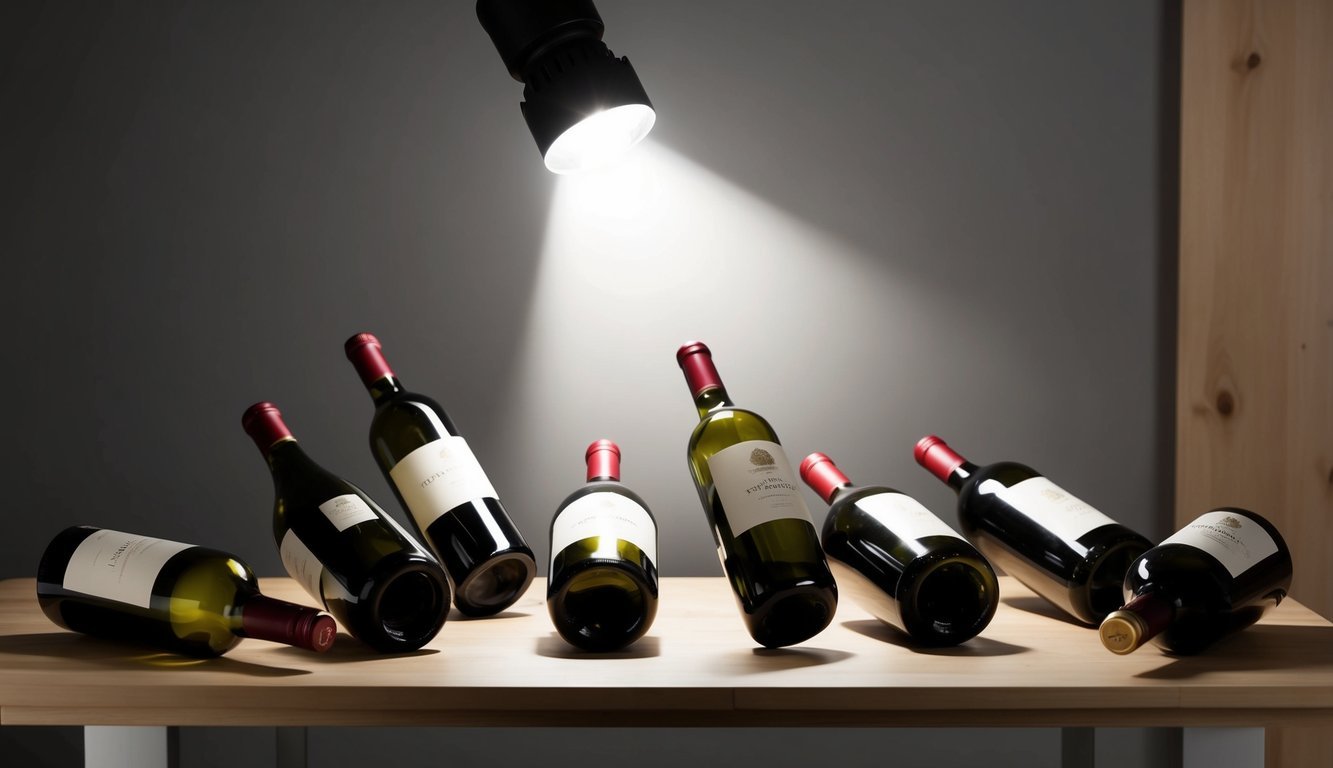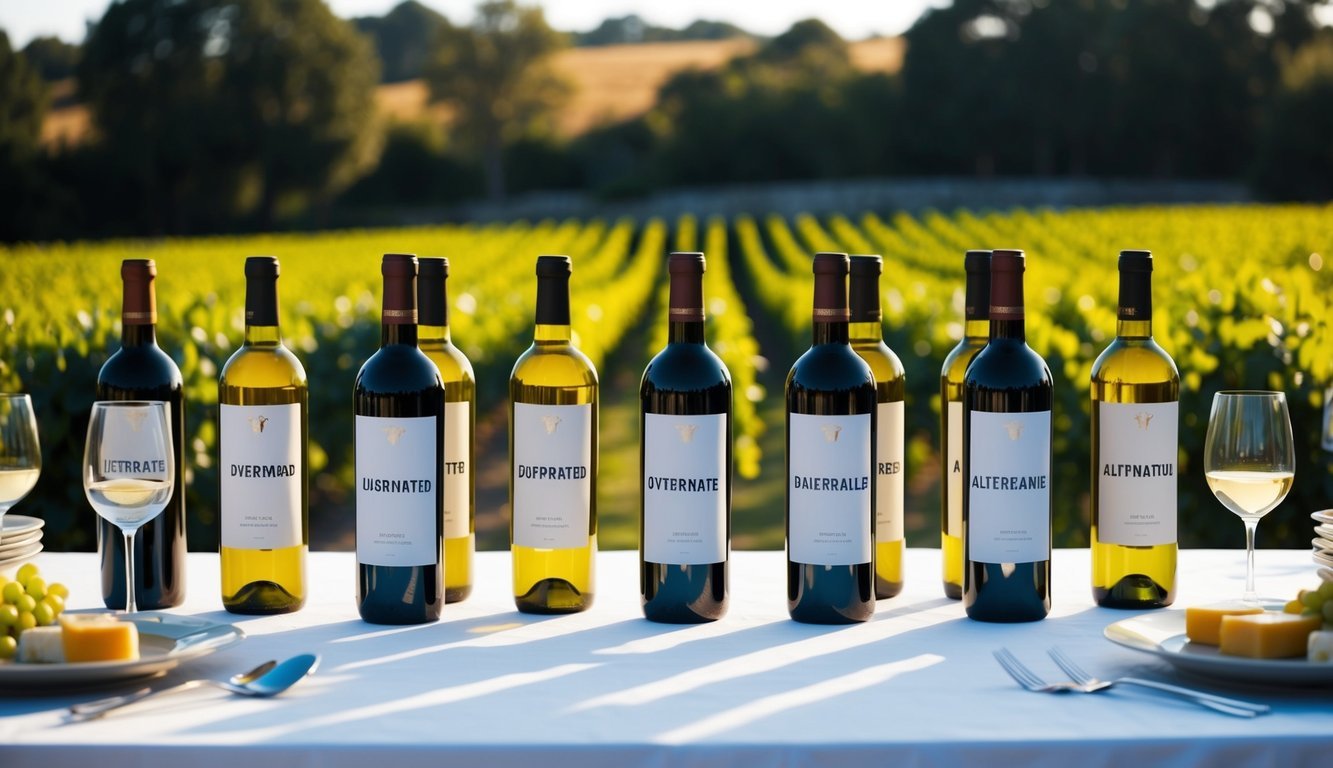Wine enthusiasts often debate which bottles are truly worth the hype.
You’ve probably encountered some popular wines that left you feeling underwhelmed, especially considering their price tags.
It’s time to explore which wines might be getting more attention than they deserve.
By discovering underappreciated alternatives, you can expand your palate and potentially save money. Let’s take a look at some wines that sommeliers and experts consider overrated, along with suggestions for what you might want to try instead.
You’ll find new favorites and gain insights to impress at your next dinner party or wine tasting event.
1) Chardonnay – Try Albariño
Chardonnay often gets a bad rap for being overly oaky and buttery.
While some enjoy this style, many find it overwhelming and monotonous.
Albariño, on the other hand, offers a refreshing alternative that might surprise your taste buds.
This Spanish white grape offers a crisp and bright profile that’s perfect for those seeking a change from heavy Chardonnays.
Albariño boasts notes of yellow apple, lemon, and mango, accompanied by a refreshing acidity.
It’s like a burst of sunshine in your glass, perfect for warm days or pairing with seafood.
You’ll find Albariños with varying styles.
Some lean towards citrusy and herbaceous flavors, while others might have a hint of sea brine, adding complexity to your sipping experience.
Many excellent Albariños are available for under $40, making them an accessible option for exploring new wines.
2) Merlot – Explore Malbec
Merlot has become a go-to red wine for many, but its popularity might overshadow its true qualities.
While it’s smooth and easy-drinking, you might find yourself craving more depth and character.
Malbec, on the other hand, brings a rich, full-bodied flavor profile to your glass.
Originating from France but now thriving in Argentina, Malbec offers a bolder, more complex experience.
You’ll notice Malbec’s deeper purple color compared to Merlot’s ruby hue.
On the palate, Malbec delivers intense dark fruit flavors like blackberry and plum, often with hints of cocoa and tobacco.
Malbec’s higher tannin content gives it a more structured feel than Merlot.
This makes it an excellent choice for pairing with hearty dishes, especially grilled meats.
3) Cabernet Sauvignon – Sip Chianti
Cabernet Sauvignon often gets more hype than it deserves.
While it’s America’s top-selling red wine, that doesn’t always mean it’s the best choice.
You might find yourself overwhelmed by its bold tannins and high alcohol content.
Many Cabs, especially from Napa, can be overpowering and lack subtlety.
Chianti, however, offers a refreshing alternative.
You’ll discover a wine with bright acidity and flavors of cherry and herbs.
Chianti’s lower alcohol content makes it more food-friendly too.
It pairs beautifully with a wider range of dishes, from pasta to grilled meats.
You’ll also appreciate Chianti’s value.
Quality bottles often come at a fraction of the price of high-end Cabernets.
4) Pinot Grigio – Enjoy Vermentino

Pinot Grigio often gets a bad rap for being bland and unexciting.
While it’s a popular choice, many wine enthusiasts find it lacks depth and character.
Vermentino, on the other hand, offers a refreshing alternative with more complexity and flavor.
This Italian white wine boasts crisp acidity and delightful aromas of citrus, herbs, and minerals.
You’ll discover notes of lemon, lime, and green apple, often accompanied by a subtle almond finish.
This versatile wine pairs wonderfully with seafood, light pasta dishes, and fresh salads.
It’s perfect for warm summer evenings or as an aperitif.
Look for Vermentino from Sardinia or Liguria in Italy for authentic expressions of the grape.
Some excellent examples are also coming from California and Australia.
5) Sauvignon Blanc – Switch to Grüner Veltliner
Sauvignon Blanc has become ubiquitous, especially those from New Zealand.
While it’s a popular choice, you might find yourself wanting something different.
Grüner Veltliner, Austria’s champion grape, offers a refreshing alternative that’s just as accessible and often more affordable.
You’ll find Grüner Veltliner has similar bright, zesty qualities to Sauvignon Blanc.
It typically features notes of white pepper, green apple, and sometimes a hint of peach.
Many Grüners have a lovely texture, ranging from light and refreshing to almost velvety in feel.
The Stadt Krems 2020 Stein Grüner Veltliner, for example, offers a medium to full body with mouth-watering acidity.
For a modern take on this classic grape, try wines from Gruber Röschitz.
This family-run winery in the Weinviertel region produces excellent examples of Grüner Veltliner.
6) Zinfandel – Opt for Tempranillo
Zinfandel has gained a reputation as a bold, fruity wine, but it often falls short of expectations.
Its high alcohol content can overpower the flavors, leaving you with a hot, unbalanced sip.
Tempranillo, however, offers a more nuanced experience.
This wine boasts similar red fruit notes to Zinfandel but with added complexity and elegance.
Tempranillo typically has a lower alcohol content, ranging from 13.5-15% compared to Zinfandel’s 14-17%.
This results in a smoother, more food-friendly wine that won’t overwhelm your palate.
You’ll find Tempranillo bursting with flavors of cherry, plum, and tobacco, often accompanied by subtle hints of leather and herbs.
Its medium-bodied nature makes it versatile for pairing with various dishes.
While Zinfandel can be hit-or-miss, Tempranillo consistently delivers quality across different price points.
You can explore excellent options from Spain’s Rioja and Ribera del Duero regions.
7) Champagne – Consider Prosecco

Champagne often gets praised as the ultimate celebratory drink, but it might not always live up to the hype.
Many large Champagne houses produce wines that can be overpriced for their quality.
Prosecco, on the other hand, offers excellent value and a refreshing taste profile.
Prosecco is made from Glera grapes using the Charmat method, which gives it a lighter, fruitier character than Champagne.
You’ll often find notes of apple, pear, and white flowers in Prosecco.
For a high-quality option, look for Prosecco from the Valdobbiadene region.
These wines showcase the best of what Prosecco has to offer, with distinctive flavors and complexity.
Prosecco’s lower price point means you can enjoy bubbly more often without breaking the bank.
It’s perfect for casual gatherings or as an aperitif.
8) Rosé – Sample Tavel

Rosé has become wildly popular, with many people reaching for the pale pink Provence-style bottles.
But you might be missing out on some truly remarkable wines.
Tavel, from the Southern Rhône Valley in France, offers a deeper, more complex experience.
Tavel rosés are known for their rich color and full-bodied flavor profile.
They’re made from a blend of grapes, typically including Grenache, Cinsault, and Syrah.
You’ll find notes of ripe strawberries, cherries, and sometimes a hint of spice in Tavel wines.
They have more structure than your average rosé, making them excellent food partners.
Domaine de la Mordorée’s La Dame Rousse is a great starting point.
It offers a balance of fruit flavors with a refreshing mineral finish.
Château d’Aqueria is another producer to look out for.
They make expressive rosés that showcase the best of what Tavel has to offer.
9) Riesling – Taste Gewürztraminer

Riesling often gets all the attention, but it’s time to give Gewürztraminer a chance.
While Riesling is known for its crisp acidity and versatile styles, Gewürztraminer offers a unique flavor profile that might surprise you.
Gewürztraminer boasts a richer, silkier texture than Riesling.
It’s less acidic and brings a bouquet of exotic aromas to your glass.
You’ll notice hints of lychee, rose petals, and spices that tantalize your senses.
If you’re looking for something different, Gewürztraminer is the way to go.
It pairs wonderfully with spicy foods and strong cheeses, making it a fantastic choice for adventurous palates.
Don’t be intimidated by its name.
Gewürztraminer is just as accessible as Riesling, but with a bolder personality.
Give it a try at your next dinner party or wine tasting event.
Remember, both wines have their merits.
But if you’re tired of reaching for the same old Riesling, it’s time to explore the world of Gewürztraminer.
You might just find your new favorite white wine.
10) Shiraz – Relish Garnacha

Shiraz, also known as Syrah, has gained a reputation for being bold and intense.
While it can be delicious, many mass-produced versions have flooded the market, leading to oversaturation and sometimes disappointing experiences.
Instead of reaching for that familiar bottle of Shiraz, why not try a Garnacha? This Spanish grape variety offers a similar flavor profile with its own unique twist.
Garnacha wines are often fruity and full-bodied, much like Shiraz.
You’ll find notes of ripe red berries, spice, and sometimes a hint of earthiness.
The difference lies in Garnacha’s often lighter tannins and higher acidity, making it more food-friendly.
Look for Garnachas from regions like Priorat or Campo de Borja in Spain.
These wines offer excellent value and can introduce you to a whole new world of flavors.
Don’t be afraid to ask your local wine shop for recommendations.
They might suggest a Garnacha blend that combines the best of both worlds, giving you a fresh perspective on big, bold reds.
Understanding Wine Ratings

Wine ratings provide a numerical score to help consumers gauge quality.
Critics and awards can significantly influence perceptions and prices in the wine market.
How Wine Ratings Work
Wine ratings typically use a 100-point scale.
Scores of 90 and above are considered excellent.
Professional tasters evaluate wines based on appearance, aroma, flavor, balance, and finish.
They consider factors like complexity, aging potential, and typicity – how well a wine represents its grape variety and region.
Some popular rating systems include those from Wine Spectator, Robert Parker, and Wine Enthusiast.
Each has its own criteria and preferences.
It’s important to note that ratings are subjective and can vary between critics.
Lower scores don’t necessarily mean bad wines.
Many enjoyable, affordable options fall in the 80-89 range.
Ratings can be helpful guides, but your personal taste is ultimately what matters most.
Influence of Critics and Awards
Wine critics wield significant power in shaping consumer preferences and market trends.
A high score from a respected critic can dramatically boost a wine’s popularity and price.
Robert Parker’s ratings, for example, have been known to make or break wineries.
Wine competitions and awards also play a role in influencing perception.
Gold medals and “Best in Show” titles can increase a wine’s prestige and demand.
However, these accolades don’t always correlate directly with quality or value.
It’s worth exploring wines beyond those with top ratings or awards.
You might discover hidden gems that suit your palate better at lower price points.
Trust your own taste buds and don’t be afraid to try wines outside the spotlight.
Alternatives To Overrated Wines

Looking beyond popular wine choices can lead to exciting discoveries.
You’ll find unique flavors and excellent value by exploring lesser-known varietals and pairing wines with seasonal foods.
Exploring Lesser-Known Varietals
Instead of reaching for that overpriced Napa Cabernet, try a bold Tannat from Uruguay.
This full-bodied red offers rich tannins and dark fruit flavors at a fraction of the cost.
For white wine lovers, swap your usual Chardonnay for an aromatic Torrontés from Argentina.
Its floral notes and crisp acidity make it perfect for summer sipping.
Fans of Italian wines might enjoy exploring the Nero d’Avola grape from Sicily.
It delivers robust flavors similar to Cabernet Sauvignon but with a unique Mediterranean twist.
Don’t overlook Portuguese wines.
The Touriga Nacional grape produces complex reds that rival more famous varieties.
Pairing Wines With Seasonal Foods
Spring calls for light, fresh wines.
Try pairing a zesty Grüner Veltliner from Austria with asparagus dishes.
Its green apple notes complement spring vegetables beautifully.
For summer barbecues, ditch the rosé and opt for a chilled red like Beaujolais.
Its bright cherry flavors stand up well to grilled meats.
As autumn arrives, embrace earthy flavors.
A Nebbiolo from Italy’s Piedmont region pairs wonderfully with mushroom risotto.
Winter comfort foods deserve a warming wine.
Consider a spicy Zinfandel from California’s Lodi region to accompany hearty stews.

